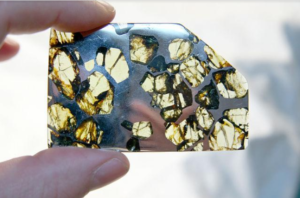Ammolite are gem-grade fossilized shells of ammonites. They are known to have spectacular display of sparkling colors in the presence of reflective lights. Different variants of ammolite produces different spectrum of colors; some only reflect one or two colors. These fossilized remains are considered gemstones because they can easily contend the exquisiteness and color strength of established gemstones such as opals and labradorite.
Anatomy of Ammolite
When dissecting the anatomy of this colorful gemstone, one comes to know that ammolite are thin gleamed coverings of ammonite fossils. It should be noted that not all ammonite fossils have ammolite as their coverings. Two species of this extinct marine molluscs are festooned with this organic gemstone. Most of the present day ammolite deposits are found along the riverside of St. Mary in Alberta, Canada.
Geological History of Ammolites
The host fossil of ammolite, ammonite was present in the waters as a living species nearly 70 million years ago. As their extinction started, the shell of dead ammonites fell to the bed of the seaway and gradually covered with mineral sediments resulting in the formation of gem-quality ammolites.
Ammolite: From Its Original Form to Gemstone
Transforming journey of ammolite from its original fossil form into a gem-grade entity is an interesting one. In the first step, the slender shell of ammonite fossil is removed from its dark shaded base. Since most of the ammolite strips are so delicate to handle therefore they are not subjected to any further processing to enhance the texture and color of the gemstone. Instead, ammolite receives the stabilization treatment. There are few steps involved in the process of stabilization:
-
- The fragile specimen of ammolite is reinforced by adding thin block to its back. Usually darker color shale slabs serve this purpose
- To protect the surface for which ammolite is known, covers of clear transparent minerals are used. Thin covers of spinel and quartz are used so that the surface of ammolite can be protected without affecting its beautiful natural display.
There is another relatively less used method to stabilize ammolite in which the specimen is soaked with an epoxy solution. Rare cuts of ammolites don’t require stabilization and can be used in jewelry in their indigenous form.
Quality Determination of Ammolite and its Uses in Ornamental Items
Apart from their size, there are few other characteristics of ammolite that determine its quality as a gemstone.
- Ammolites that display more than one glowing color
- Ammolites that display the phenomenon of iridescence from various angles
- Ammolites with color bends that are not broken up by gaps are also considered very precious. Gaps are formed ammolite surfaces due to fractures and the inclusion of other minerals
Ammolites that fulfill all these three requirements are then cut and used in different type of jewelry. Capping or transparent covering of the stones is done as per the customer’s requirement. For instance, people who want to have the best and more natural view of ammolite will prefer less dooming. On the other hand, some people like this dooming because it enhances the visual character of the stone.
Ammolites that are totally uncapped or covered can be used in jewelry items such as earrings, pins, and brooches that are less likely to face abrasion.
Historical Significance of Ammolite in Different Cultures and Religions
In Hinduism
Ammonites found in the fossil sediments of Gandaki River in Nepal usually show golden luminescence and have been used to show the characteristics of Vishnu and his chakra. This attribution of the stones earned itself veneration from Hindus.
In Native America
To the Niitsitapi nation of Native America, ammolite and other fossil stones are associated with an abundance of resources, healing and good fortune.
In Chinese Culture
The believers of the ancient Feng Shui philosophy recommend ammolite as the stone used to cure financial problems. Ammolite is also named after a mythological Chinese beast ‘Qilin’ and hence called Qilin or Kirin Stone. In Chinese tradition, ammolite is also attributed to traits of longevity and non-violence.
It is interesting to see that the same stone is revered in different geological locations and demographics for different reasons. However, it can be inferred that this shared reverence from different cultures and religions is there due to ammolite’s unique iridescence.







 Silver is often overlooked and overshadowed by the yellow glistening of gold. It seems as if this mineral (considered a mineral when in its native form) plays second fiddle to its more precious cousin. However, this doesn’t change many distinctive facts about this shiny metal. In this article, we will try to discuss a different aspect of this valuable and noble mineral.
Silver is often overlooked and overshadowed by the yellow glistening of gold. It seems as if this mineral (considered a mineral when in its native form) plays second fiddle to its more precious cousin. However, this doesn’t change many distinctive facts about this shiny metal. In this article, we will try to discuss a different aspect of this valuable and noble mineral.

